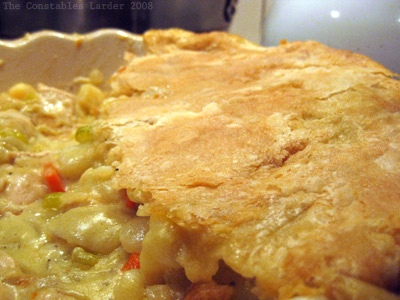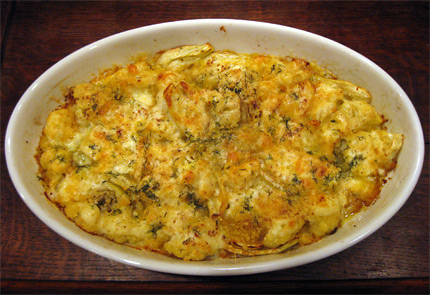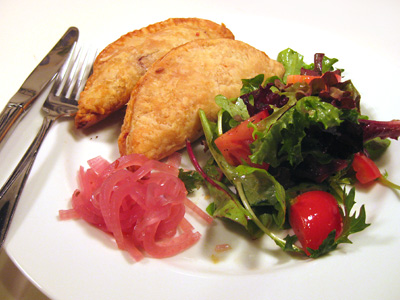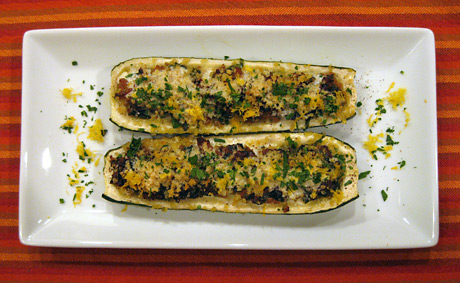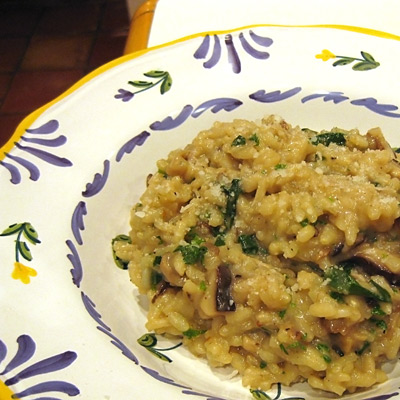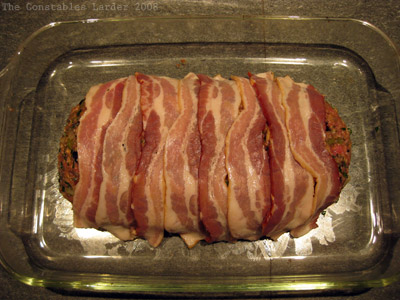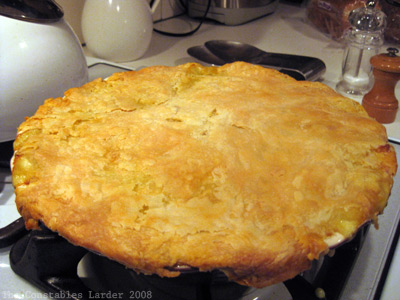
On Saturday, we crawled through traffic back up the Eastern seaboard and returned from visiting family in Washington DC. There are few things more soul destroying than hours stuck traffic. Naturally, I needed to make a chicken pot pie to recuperate. Chicken pot pie is scientifically proven to pack high levels of emotionally recuperative bosons and gluons by the ounce.
It is a little known fact that they plan to test FermiLab’s Large Hadron Collider by accelerating a chicken pot pie to the speed of light and thus duplicating comfort food conditions at the origins of the universe. It will either cause the end of the world, or it won’t; there appears to be some debate, which is comforting in and of itself.
Below is a recipe for a simple pot pie, and a decent framework for elaborating upon with other ingredients (leeks, peas, turnips, parsnips) and herbs (parsley, rosemary, oregano, tarragon, etc). Note: I hope you’ll excuse the hack-job of the pastry edging in the above picture… I was moving fast in a race against the clock for Munchkin’s dinner time.
Chicken Pot Pie
1.5 lb chicken breast, cut into 1/2 inch cubes
2 medium red potatoes, cut into 1/4 to 1/2 inch cubes
1 white onion, diced
3 medium/large garlic cloves, peeled, woody end removed, and minced
3 medium carrots, sliced into 1/4 inch rounds or smaller
3 celery stalks, cut into 1/4 inch slices
1 tsp ground savory (alternative: 1 tbsp parsley and/or 1/2 tsp dry thyme)
1/2 cup dry white wine
salt and pepper
olive oil
5 tbsp unsalted butter
1/2 cup flour
2 cups milk
2 cups chicken stock (or water)
Pastry
1 1/4 cup flour
1/4 tsp salt + a couple more pinches
7.5 tbsp butter
approx 5 tbsp ice cold water
Egg wash: 1 tbsp water, 1 egg yolk
Making the Pastry
For this pot pie, I decided to work off of Alice Waters’ savory pastry proportions from The Art of Simple Food. I was only making the pastry for the top, so reduced the amounts from the 2 cups of flour in her book, keeping with her proportions (hence the extra pinches of salt to get to around 1/3 tsp).
Cut the butter into 1/4 inch cubes and place in the freezer for 15 minutes. Fill a glass with ice water and place next to your food processor. Combine the flour and salt in a food processor and pulse a few times to mix. Add the butter to the processor and add 4 tablespoons of the ice water, pulsing the mixture between each tablespoon.
Remove the mixture to a clean surface and gently work it together. If it is not holding together at all, add another tbsp of the ice water. When the crumbly mixture is just holding together (you do not want it sticky or wet, and it is ok to have a little still crumbly), form into a rough ball, wrap in plastic wrap, flatten, and place in the fridge for an hour.
Preparing the Filling
Preheat the oven to 375F.
Bring some lightly salted water to boil in a medium sauce pot and boil the potato until just tender, no more than 10 minutes given the small cut. Drain or remove to a bowl with a slotted spoon, and keep the sauce pot around for the white sauce.
Heat a splash of olive oil in a large saute pan on medium heat and brown the chicken, then remove to the bowl with the potato. Lower the heat to medium-low and saute the onions and garlic for a couple of minutes, then add the carrots. Cook for 5 minutes, then add the celery, ground savory (or other herbs), white wine, and a couple pinches of salt and pepper. Cook for another few minutes then turn off the heat.
At this point, turn to the sauce pot: melt 5 tbsp of butter on medium-low heat, then wisk in the 1/2 cup of flour and cook for a minute stirring regularly. Theoretically, it is best to have your milk and stock (or water) already at a near boil, but if you haven’t had time or the energy to dirty another pot, it isn’t the end of the world just to add them directly now. Cook at a gentle simmer for another 5 minutes. (If you like your pie really rich, you can add 1/4 cup of cream too)
Stir the white sauce into the saute pan with the vegetables and taste for salt and pepper. Then stir in the chicken and potato. Spoon the mixure into your pie dish until it is near the edge.
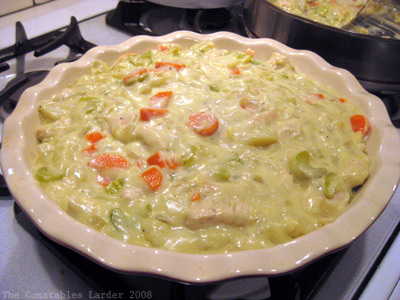
Photo note: the mixture looks a little green-ish because of the ground savory.
Finishing the Pie
Remove the wrapped pastry from the fridge, and on a lightly floured surface, with a floured rolling pin, roll out your pastry into a thin layer an inch or so bigger than you need for the pie dish. Lightly flour the top, to prevent it from sticking, and gently fold the pastry in half or in quarters to safely lift it in one piece to the top of the pie dish. Crimp the pastry around the edge of the pie dish, and then cut off any excess pastry hanging over the edge with a sharp paring knife. Make some vent holes in the top with the knife (or a fork).
If you have the time, it is nice to mix an egg yolk with a tbsp of cold water and brush this egg wash on top of the pastry. (I did not, this time around)
Place the pie in the oven (which was pre-heated to 375F) for 45 minutes, then let cool for 10 or 15 minutes before serving.
